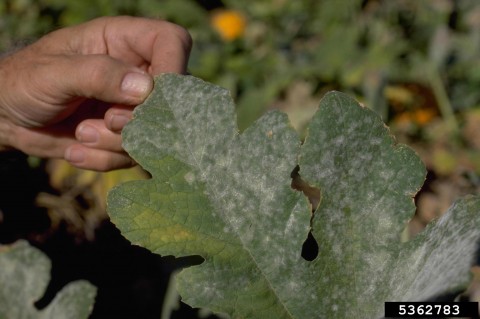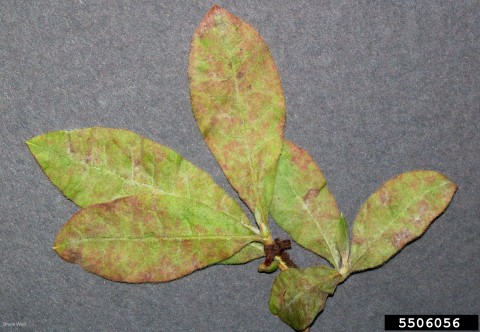
Powdery mildew on pumpkin plant. Photo: Howard F. Schwartz, Colorado State University, Bugwood.org.
Late summer in western Washington provides ideal conditions for powdery mildew. Powdery mildew is common on a wide range of plants, including annuals, perennials, food crops and ornamental shrubs. To help you manage it, we are updating a post on powdery mildew from last summer.
Powdery mildew does best when damp nights are followed by warm, sunny days, such as in late summer and fall. There are many different species of powdery mildew, and each species only attacks plants in a specific family.

On rhododendron, symptoms include spotted leaves, with brownish-purple or yellow spots on the underside and sometimes ring-shaped spots on the upper leaf surface. Photo: Bruce Watt, University of Maine, Bugwood.org.
How to identify
Common symptoms on plants such as squash, pumpkins and roses are white spots on the leaves. The leaves look like they’ve been dusted with flour or talcum powder. The spots gradually spread over wide areas of the leaves and stems. On other plants, such as artichokes, tomatoes and rhododendrons, spots may be yellow, purple or brown.
What you can do
The best method of control is prevention. The first step is to choose disease-resistant plants or varieties. Many plants have cultivars bred to resist powdery mildew.
The American Rhododendron Society has lists of resistant varieties, localized to western Washington areas.
Here is a list of resistant ornamentals from the University of California Statewide Integrated Pest Management Program.
| Susceptible Plant | Resistant Cultivars |
|---|---|
| crape myrtle | those with Native American names, e.g., ‘Catawba,’ ‘Cherokee,’ ‘Hopi’ |
| euonymus | variegated varieties more resistant than nonvariegated types |
| London plane tree | ‘Yarwood,’ ‘Columbia,’ ‘Liberty’ |
| monarda | ‘Marshall’s Delight,’ ‘Blaustrumph,’ ‘Colrain Red’ |
| phlox | Phlox maculata ‘Natasha,’ P. glaberrima ‘MorrisBerd,’ P. paniculata ‘Robert Poore,’ ‘David’ |
| rose | ‘Simplicity’ and ‘Meidiland’ roses, Rosa rugosa varieties |
| rhododendron | R. yakushimanum, R. macrophyllum, R. ‘Nova Zembla,’ R. ‘Palestrina’ |
| zinnia | Pulcino and African zinnias |
Use good cultural practices: provide good air circulation and don’t over-fertilize. Be careful about where your plants are situated. Plants that are next to the house may get powdery mildew even if they are not prone to the disease.
Overhead watering may actually reduce the spread of powdery mildew because it washes spores off the plant. Water in the morning so plants can dry out, reducing the potential for infection by other fungal diseases, such as rust or black spot.
Pruning can help. Prune out dense growth to help increase air circulation. Prune out severely affected leaves when symptoms are present.
Begin monitoring for powdery mildew symptoms in mid-summer. Call us if you are concerned.
Sometimes a fungicide may be needed. There are several less-toxic fungicides available, including horticultural oils, neem oil, jojoba oil, sulfur, and the biological fungicide Serenade.
With the exception of the oils, these work best when applied to susceptible plants before symptoms appear or in the earliest stages of the disease. They only work on contact, so be sure to cover all parts of the plant. You may need to apply again, every seven to 10 days, as the plant grows.
If mild to moderate powdery mildew is present, you can use horticultural and plant-based oils such as neem or jojoba oil. Oils are most useful in eradicating, rather than preventing, the disease.
